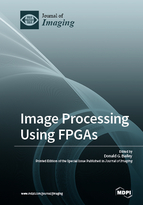Image Processing Using FPGAs
A special issue of Journal of Imaging (ISSN 2313-433X).
Deadline for manuscript submissions: closed (30 November 2018) | Viewed by 74889
Special Issue Editor
Interests: machine vision; FPGA based design; digital image processing
Special Issues, Collections and Topics in MDPI journals
Special Issue Information
Dear Colleagues,
Field Programmable Gate Arrays (FPGAs) are increasingly being used for the implementation of image processing applications. This is especially the case for real-time embedded applications, where latency and power are important consideration. An FPGA embedded in a smart camera is able to perform much of the image processing directly as the image is streamed from the sensor, providing a processed data stream, rather than images. The parallelism of hardware is able to exploit the spatial and temporal parallelism implicit within many image processing tasks. Unfortunately, simply porting a software algorithm onto an FPGA often gives disappointing results, because many image processing algorithms have been optimised for a serial processor. It is usually necessary to transform the algorithm to efficiently exploit the parallelism and resources available on an FPGA. This can lead to novel algorithms and hardware computational architectures, both at the image processing operation level and also the application level.
The aim of this Special Issue is to present and highlight novel algorithms, architectures, techniques and applications of FPGAs for image processing.
Prof. Donald Bailey
Guest Editor
Manuscript Submission Information
Manuscripts should be submitted online at www.mdpi.com by registering and logging in to this website. Once you are registered, click here to go to the submission form. Manuscripts can be submitted until the deadline. All submissions that pass pre-check are peer-reviewed. Accepted papers will be published continuously in the journal (as soon as accepted) and will be listed together on the special issue website. Research articles, review articles as well as short communications are invited. For planned papers, a title and short abstract (about 100 words) can be sent to the Editorial Office for announcement on this website.
Submitted manuscripts should not have been published previously, nor be under consideration for publication elsewhere (except conference proceedings papers). All manuscripts are thoroughly refereed through a single-blind peer-review process. A guide for authors and other relevant information for submission of manuscripts is available on the Instructions for Authors page. Journal of Imaging is an international peer-reviewed open access monthly journal published by MDPI.
Please visit the Instructions for Authors page before submitting a manuscript. The Article Processing Charge (APC) for publication in this open access journal is 1800 CHF (Swiss Francs). Submitted papers should be well formatted and use good English. Authors may use MDPI's English editing service prior to publication or during author revisions.
Keywords
- Hardware algorithms for imaging
- Computational imaging architectures
- Reconfigurable image processing systems
- Parallel image processing
- Hardware acceleration for imaging applications
- FPGA based smart cameras







